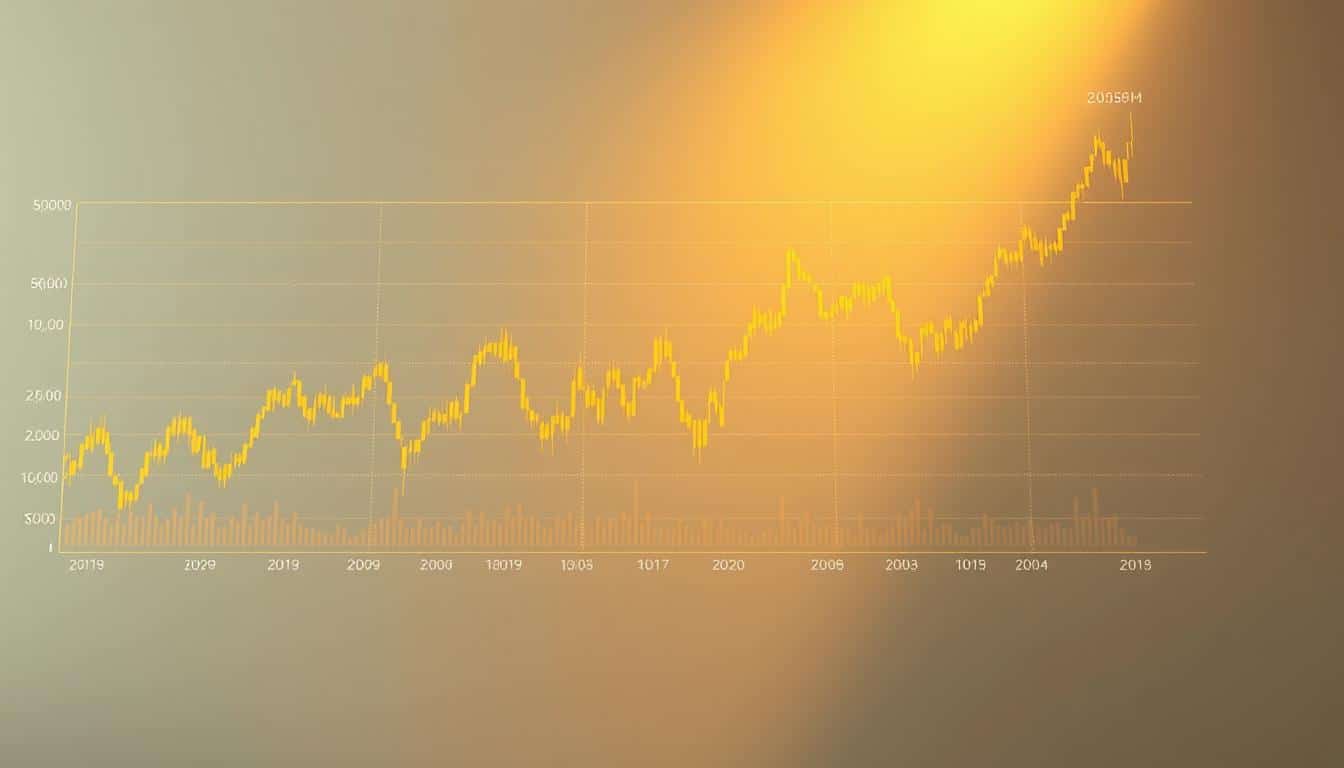Gold hit $4,381.52 per ounce on October 20, an all-time record. This 30% surge since mid-August is more than typical market fluctuations. It signals bigger economic shifts.
Gold price charts tell stories about economic uncertainty. They show where smart money goes when currencies weaken. The U.S. dollar’s 9% drop this year is directly fueling the rally.
Standard Chartered Bank’s analysis carries real weight. Their Senior Analyst predicts $4,300 per ounce within three months. He projects a possible $4,500 in a year.
Understanding these patterns could be a smart financial skill. It matters for both new investors and those already holding gold. Knowing when to act can make a big difference.
Key Takeaways
- Precious metal reached an all-time high of $4,381.52 per ounce on October 20, marking a historic milestone
- Values have surged more than 30% since mid-August, driven by economic uncertainty and currency weakness
- Standard Chartered Bank forecasts continued growth to $4,300 in three months and $4,500 within 12 months
- The U.S. dollar has weakened 9% year-to-date, creating an inverse relationship that supports the rally
- Reading gold price trends effectively requires understanding the connection between currency movements and precious metal valuations
- Institutional analysis from major financial institutions provides credible projections beyond speculation
Understanding Gold Price Trends
Gold price trends repeat because fear repeats. The patterns are predictable responses to specific crises. Understanding what drives these movements helps make strategic decisions based on historical data.
Gold market analysis is about recognizing human behavior behind chart lines. Each spike tells a story of investor fears at that time.
Historical Price Movements
Gold prices respond to specific crisis patterns in modern financial history. The 2008 financial crisis triggered a flight to safety as banks collapsed.
In 2011, the European debt crisis brought uncertainty. Greece neared bankruptcy, and fears spread across other European countries.
2022 marked a structural turning point that changed everything. The U.S. and EU froze Russian assets, causing emerging market central banks to rethink.
| Crisis Period | Primary Driver | Gold Price Response | Duration of Impact |
|---|---|---|---|
| 2008 Financial Crisis | Banking system collapse | +25% increase | 18 months |
| 2011 European Debt Crisis | Sovereign default fears | +18% increase | 12 months |
| 2022 Russian Sanctions | Asset freezing precedent | +30% increase | Ongoing structural shift |
| 2023-2024 Rate Cut Cycle | Monetary policy pivot | +22% increase | Current momentum |
The Russian asset freeze created permanent demand from central banks. Countries are diversifying away from dollar reserves into gold as insurance.
Temporary crises create temporary spikes. Structural changes in reserve asset views create sustained upward pressure.
Key Factors Influencing Price Changes
Traditional drivers like inflation still matter, but the gold market is more complex now. Currency weakness used to be the main catalyst.
Today, multiple new variables exist. Geopolitical fragmentation tops the list as the world splits into competing spheres of influence.
De-dollarization isn’t a conspiracy theory anymore. It’s active policy in multiple G20 nations seeking to reduce dependence on dollar-denominated trade and reserves.
Central bank purchases have increased dramatically. They bought over 1,000 tonnes of gold in 2022 and 2023.
The Trump administration introduced new concerns about U.S. debt sustainability. Large deficits during economic expansion worry investors about future recessions.
Federal Reserve independence has become a concern. Political pressure on monetary policy undermines confidence in dollar stability.
Interest rate policy remains crucial but with a twist. Real interest rates matter more than nominal rates.
Recent Trends and Observations
Gold prices surged over 30% since mid-August, surprising many analysts. This aggressive move suggests multiple catalysts aligning simultaneously.
The Federal Reserve resumed rate cuts in September. Another 25 basis point reduction is expected soon.
Institutional buyers create sustained momentum, unlike volatile retail investor spikes. Central banks are systematically increasing gold reserves.
Negative real interest rates correlate with strong gold performance. Gold preserves purchasing power better in this environment.
Currency concerns have intensified beyond typical dollar weakness. Many emerging market currencies have sharply devalued.
We’re in a rare period where every major catalyst is pushing gold prices in the same direction.
The Importance of Gold as an Investment
Gold behaves differently from other assets, making it crucial for portfolio construction. Its recent 30% surge amid market uncertainty showcases its role as a protective asset. Gold climbs when other investments falter, shielding wealth during turbulent times.
Gold’s purpose goes beyond simple returns. It safeguards money when other investments fail. This unique characteristic makes it an essential part of a well-rounded investment strategy.
Historical Returns on Gold Investments
Over two decades, gold has averaged 9-10% annual returns. These numbers are significant because gold provides portfolio insurance during market crashes. It outperforms during crises, even if stocks deliver stronger returns in calm markets.
Gold climbed during the 2008 financial crisis and the 2020 COVID-19 panic. It preserved wealth during 1970s stagflation and maintained value during currency crises. The value isn’t in beating stocks every year—it’s in not losing everything when markets break.
Gold vs. Other Investment Options
Comparing gold to other investments requires considering correlation and purpose, not just returns. Each asset class serves different functions in a well-constructed portfolio. Gold’s negative correlation with stocks during crises is particularly valuable.
Standard Chartered maintains a 7% gold allocation in balanced portfolios. This shows gold’s strategic importance beyond speculation. They use it as portfolio ballast, not for gambling on prices.
| Asset Type | Average Annual Return | Primary Risk | Crisis Performance |
|---|---|---|---|
| Stocks | 10% | Market volatility | Often decline sharply |
| Bonds | 4-6% | Inflation, default | Variable performance |
| Real Estate | Varies by location | Illiquidity, local factors | Can decline or freeze |
| Gold | 9-10% | No yield generation | Typically rises or stable |
Unlike bonds, gold can’t default but doesn’t pay interest. It’s more liquid than real estate and independent of corporate decisions. Each comparison reveals different trade-offs worth considering for a balanced investment strategy.
Benefits of Holding Physical Gold
Physical gold offers unique advantages over gold ETFs or mining stocks. It can’t be hacked, diluted, or bankrupted. There’s no counterparty risk, unlike with ETFs or mining stocks.
Physical gold cannot be hacked, diluted, or bankrupted. It’s globally recognized as valuable, regardless of language or local currency. During extreme scenarios, physical gold maintains value when digital assets might become inaccessible.
Gold’s role as a neutral, non-political asset is growing. No government can print more gold or devalue it through monetary policy. This independence is increasingly important in today’s uncertain economic environment.
Institutional and retail ownership of gold remains relatively low despite recent strong performance. ETF inflows are accelerating, suggesting room for more investors to enter the market. This creates potential for continued gold allocation growth across diversified portfolios.
How to Read a Gold Price Chart
Gold price charts aren’t as complex as they seem. They tell simple stories about buyers and sellers. Learning what each part means helps you spot patterns and trends for smarter investing.
I used to glance at charts without understanding them. Then I focused on the basics. These work for daily checks or long-term planning.
Basic Chart Components Explained
Gold charts have standard parts showing market activity. The vertical axis shows price in dollars per troy ounce. The horizontal axis displays time, which can span hours to years.
Price lines or candlesticks show gold’s actual trading value. This is the core information for interpretation. Upward movement means more buyers, downward means more sellers.
Volume bars at the bottom show how much gold was traded. High volume during price increases suggests strong market conviction. Low volume changes might not last long.
Moving averages are smooth lines showing the general trend. The 50-day and 200-day averages are common. When shorter averages cross above longer ones, it’s seen as positive.
Support and resistance levels mark prices where gold bounces or gets rejected. Traders watch these closely, creating self-fulfilling patterns useful for timing decisions.
Types of Gold Price Charts
Different chart styles serve various purposes. Your choice depends on the timeframe and detail level you need. Line charts are simplest, connecting closing prices with a line.
Candlestick charts offer more info per bar. The body shows opening and closing prices. Wicks display highest and lowest prices reached.
Green or white candles mean gold closed higher, which is bullish. Red or black candles show lower closing prices, signaling bearish sentiment.
Bar charts display similar data to candlesticks but less visually. Each bar shows high, low, open, and close with small ticks. Some prefer these for precision.
| Chart Type | Information Provided | Best Used For | Complexity Level |
|---|---|---|---|
| Line Chart | Closing prices only | Long-term trend identification | Beginner-friendly |
| Candlestick Chart | Open, high, low, close prices plus sentiment | Detailed analysis and pattern recognition | Intermediate |
| Bar Chart | Open, high, low, close prices | Technical precision analysis | Intermediate to Advanced |
| Point and Figure | Price movements without time element | Identifying support and resistance | Advanced |
Monthly or weekly candlesticks help spot major trend changes. Daily charts can identify short-term pullbacks for better entry points when buying.
Tips for Interpreting Price Data
First, always zoom out. A daily alarm might be a yearly blip. Context matters when evaluating trend changes versus normal swings.
Look for trend confirmation, not single-day moves. Three higher highs and lows suggest an uptrend. The opposite pattern indicates a potential downtrend.
Watch volume with price movements. Price increases with rising volume are more reliable. Strong volume confirms many traders agree with the direction.
Remember, charts don’t predict the future. They show past events and help identify probabilities. Past performance doesn’t guarantee future results, as disclaimers state.
Use multiple timeframes for full perspective. Check long-term trends first, then zoom in for precise timing. A daily dip might be a pause in a strong monthly uptrend.
Here’s what I check weekly when reviewing price data:
- The overall direction on monthly and yearly charts
- Recent support and resistance levels being tested
- Volume patterns during significant price movements
- Moving average positions and potential crossovers
- Any emerging patterns that historically precede trend changes
Don’t obsess over small changes. Focus on multi-week and multi-month trends that support your investment plan. Fifteen minutes of weekly chart review often beats daily price checks.
Understanding charts changes how you view market info. You’ll see stories about supply, demand, and sentiment. This helps you make smarter decisions about buying, holding, or adjusting gold positions.
Current Gold Prices: A Graphical Overview
Gold prices tell a story through charts. These reveal market emotions: surges, consolidations, and corrections. We’re witnessing a remarkable chapter in gold’s history right now.
Charts show investor sentiment better than spreadsheets. They capture the rhythm of the market. I’ve studied these patterns for years.
Daily Gold Price Chart
The daily gold chart shows a surprising trend. On October 20, gold reached $4,381.52 per ounce. This is an all-time high, up 30% since mid-August.
Gold usually rises slowly, gaining 1-2% monthly in bull markets. This rapid rise is unusual. The steepness stands out when compared to historical patterns.
Standard Chartered analysts see this as healthy. The price is now consolidating after the peak. Rajat Bhattacharya calls it “a healthy correction after a record-breaking rally”.
They predict a possible dip to $3,945-$4,060 per ounce. This would be a 7-10% correction from the peak. It could create a better entry point for long-term investors.
Current gold prices likely range from $4,000-$4,300. The exact price depends on when you’re reading this. It also varies with different market sessions throughout the day.
Monthly and Yearly Trends
Monthly charts show a broader picture. Gold stayed between $1,900 and $2,400 for much of 2023 and early 2024. Then it broke out higher.
This consolidation built energy for the next move. It’s like a coiled spring. Longer compression leads to a more explosive breakout.
The yearly trend is clearly bullish. Gold has made higher lows since the 2022 bottom around $1,630. This is a reliable bullish signal.
Standard Chartered expects $4,300 in three months and $4,500 in twelve. This suggests the uptrend will continue. Gold has doubled from $2,000 to $4,000 in five years.
| Timeframe | Price Range | Key Pattern | Investor Insight |
|---|---|---|---|
| Daily | $4,000-$4,381 | Post-peak consolidation | Short-term volatility normal |
| Monthly | $1,900-$4,381 | Breakout from range | Momentum shift confirmed |
| Yearly | $1,630-$4,381 | Higher lows established | Structural bull market intact |
| 5-Year | $2,000-$4,381 | Doubling in value | 15% annualized returns |
Interactive Gold Price Chart Tools
Interactive gold price charts have improved greatly. Regular investors can now access tools once reserved for professionals. I’ve tested many platforms, and several stand out.
Kitco, GoldPrice.org, and BullionVault offer real-time or near-real-time tracking. These sites have customizable charts with various timeframes and display options.
Many brokers include gold price charts in their platforms. TD Ameritrade, Interactive Brokers, and Robinhood offer this feature. This lets you view gold prices alongside other investments.
TradingView is great for dedicated price tracking. It allows custom alerts and asset comparisons. You can spot correlations or divergences that inform investment decisions.
Key features to look for in a live gold price tracker include:
- Update frequency: Real-time if you’re actively trading, end-of-day if you’re investing long-term
- Customizable timeframes: Ability to view 1 day, 1 week, 1 month, 1 year, 5 years, or maximum history
- Technical indicators: Moving averages, RSI, MACD, and Bollinger Bands for analysis
- Alert functionality: Price notifications delivered via email or mobile push notifications
- Clean interface: Information presented clearly without overwhelming complexity
Find a tool that updates often enough for you. It should present information clearly. I use three platforms for different purposes.
One is for quick mobile checks. Another is for detailed desktop analysis. The third is for setting long-term alerts.
Gold Price Predictions for 2024
Gold’s rally has analysts buzzing. Most see continued growth, not a drop after the 30% surge. These predictions come from banks managing billions in capital.
The bullish outlook isn’t wishful thinking. It’s based on lasting factors that won’t disappear soon.
What Major Analysts Are Predicting
Standard Chartered Bank has a bold forecast. They predict gold will hit $4,300 per ounce in three months. In a year, they expect $4,500 per ounce.
This view shows confidence even after big gains. Other banks share this optimism, though not all agree.
Some see gold staying between $3,800 and $4,200. But most major banks lean positive overall.
Three factors drive this confidence. Ongoing global tensions, U.S. debt worries, and countries moving away from the dollar. Standard Chartered advises buying during price dips.
Trump’s possible return adds uncertainty. This boosts gold’s appeal as a safety net against policy changes.
Key Economic Indicators Worth Watching
Traders watch specific economic signs linked to gold prices. These indicators help predict where gold might go.
Federal Reserve interest rate decisions top every analyst’s list. The Fed cut rates in September. Another cut is expected soon.
Markets expect about 125 basis points of total cuts next year. Rate cuts make gold more attractive.
Real interest rates matter too. They show the true return on cash and bonds. Negative real rates make gold more appealing.
The U.S. dollar’s strength affects gold prices. A weaker dollar makes gold cheaper for foreign buyers. The dollar has dropped 9% this year.
Here’s a guide to these economic indicators and how they affect gold:
| Economic Indicator | Bullish Signal for Gold | Bearish Signal for Gold | Current Status |
|---|---|---|---|
| Federal Reserve Rates | Cutting rates aggressively | Raising or holding rates high | Cutting (125bps expected) |
| Real Interest Rates | Negative or near zero | Strongly positive (3%+) | Declining toward neutral |
| U.S. Dollar Index | Weakening significantly | Strengthening on safe-haven demand | Down 9% year-to-date |
| Geopolitical Risk | Escalating conflicts or trade wars | Easing tensions globally | Elevated and persistent |
| Central Bank Purchases | Sustained accumulation | Net selling by major banks | Strong buying continues |
U.S. debt levels support gold long-term. With $33 trillion in debt, gold looks good compared to dollar assets. This creates steady demand.
Central bank gold purchases also matter. They create lasting demand beyond investor sentiment. Emerging markets keep buying gold reserves.
Seasonal Patterns and Physical Demand
Gold prices show seasonal trends. These are less reliable than economic factors but worth knowing.
Gold often dips in March and April as Indian wedding season ends. It then rises into September and October for festival season.
Chinese New Year brings another buying wave in January or February. Gold gifts are traditional during this celebration.
However, high prices have reduced physical demand in price-sensitive markets like India. Jewelry buyers hesitate above $4,000 per ounce.
Lunar New Year buying could still provide support. Traditional gift-buying might limit price drops.
One risk: if U.S. economic data surprises or inflation rises, the Fed might delay rate cuts. This could strengthen the dollar and hurt gold.
Overall, gold seems likely to rise. But expect bumps along the way. The factors supporting gold remain strong.
Frequently Asked Questions About Gold Pricing
Investors often ask about gold pricing trends. Understanding these patterns can shape your investment decisions. Let’s explore the key factors that drive gold prices.
I’ve tracked these trends for years. Here are answers to the three most common questions. My responses are based on current market data.
What Influences Gold Prices Most?
Uncertainty is the main driver of gold prices. This includes economic, political, monetary, and geopolitical factors. The mechanisms behind this uncertainty are crucial.
The 2022 freezing of Russian assets changed the game. Central banks realized their dollar reserves carried political risk. This led to increased gold purchases by many countries.
This creates sustained demand independent of investor sentiment. It’s a major factor in current gold price trends.
- Federal Reserve monetary policy: Rate cuts weaken the dollar and reduce gold’s opportunity cost
- Political uncertainty: Concerns about U.S. fiscal discipline amplify safe-haven demand
- Currency movements: The dollar’s decline directly supported gold’s rally
- Geopolitical tensions: Conflicts push investors toward neutral, non-political assets
- De-dollarization trends: Countries reducing dollar dependence create long-term demand for alternatives
These factors are reinforcing each other in the current market. This explains why institutions maintain significant gold allocations. They’re responding to multiple converging trends.
How Accurate Are Predictions?
Gold price predictions are mixed at best. I’ll be transparent here. Sugarcoating doesn’t help anyone make informed decisions.
Reputable institutions tend to predict direction better than specific prices. Their projections are based on sound analysis of observable factors.
However, unexpected events can derail even well-reasoned forecasts. Geopolitical changes or economic shifts could alter the trajectory quickly.
Historically, analysts have underestimated major bull moves. They’ve also overestimated during consolidation phases. Predictions from active money managers tend to be more credible.
View predictions as probability-weighted scenarios, not guaranteed outcomes. Use them to understand fundamental logic and risk factors.
Should I Buy Gold Now or Wait?
If you have no gold exposure, consider building a position gradually. Most experts advise against waiting for the “perfect” entry.
Averaging in during periods of weakness is a sound strategy. Timing the bottom is nearly impossible.
Analysts suggest temporary dips to $3,945-4,060 before prices climb toward $4,300-4,500. Waiting for a pullback could offer better entry.
Dips below $4,000/oz would likely be buying opportunities for long-term investors.
The risk of waiting is missing out if prices spike. External events could drive prices up before you establish a position.
Here’s a balanced approach if you have no gold position:
- Buy 40-50% of your intended allocation immediately
- Set limit orders to purchase more if prices drop to $4,050 and $3,950
- Keep cash ready to average in on weakness
This strategy balances exposure and caution. It avoids sitting entirely in cash if gold continues rallying.
Institutional buyers see sub-$4,000 prices as attractive. This indicates where smart money finds value. Strategic patience beats perfectionism when investing in trending assets.
Tools for Tracking Gold Prices
Modern tracking tools for gold are sophisticated and accessible. You can find real-time pricing, historical analysis, and portfolio integration. These tools rival institutional platforms without the hefty price tag.
Choose a tool that matches your investment style. Don’t get sidetracked by features you won’t use.
Best Apps and Websites for Gold Prices
Kitco (kitco.com) is the go-to for precious metals pricing. They offer real-time spot prices, futures data, and extensive historical charts. Their market commentary from traders provides valuable insights.
Kitco updates constantly during market hours. It displays gold prices in multiple currencies, useful for tracking international markets.
GoldPrice.org offers a simpler approach for current pricing. Their charts are customizable with timeframes from one day to 30 years. They show gold priced in over 160 currencies.
BullionVault combines price tracking with buying and selling functions. It’s ideal if you want to hold allocated gold in secure vaults.
The mobile app “Gold Price Live” provides real-time pricing. It offers customizable weight units and currency conversions. Its clean interface allows quick price checks.
TradingView’s app excels in technical analysis. You can overlay indicators, draw trendlines, and compare gold against other assets. It offers professional-grade charting tools for serious traders.
Investing.com’s app includes gold prices alongside broader market data. This helps track correlations between gold and other assets. Seeing gold’s movement relative to other indices provides valuable context.
Digital tracking tools are crucial for retail investors. They offer accessible monitoring without needing institutional resources.
Setting Up Price Alerts
Price alerts prevent compulsive checking while ensuring you don’t miss significant moves. Most platforms offer custom notifications that work reliably.
TradingView allows specific alerts like “notify me when gold crosses above $4,300”. These can trigger via email, push notification, or SMS. Set alerts at key technical levels for better monitoring.
Kitco’s mobile app offers percentage-based alerts. You can set notifications for specific price movements. Use both level and percentage alerts for comprehensive monitoring.
Setting alerts helps you focus on other tasks. It reduces stress and leads to better decision-making.
Other Useful Resources
The World Gold Council (gold.org) publishes quarterly demand reports. These show central bank purchases, jewelry demand, and investment flows. Understanding these fundamentals provides valuable perspective on price movements.
Track Federal Reserve meeting calendars and interest rate announcements. These directly impact gold pricing. Following Fed communication helps anticipate market volatility.
COMEX gold futures data reveals professional traders’ positions. This provides insight beyond retail sentiment.
For ETF investors, track flows into funds like GLD or IAU. This shows institutional and retail money movements.
Reddit’s r/Gold and r/Silverbugs offer real-world perspectives from buyers and collectors. These discussions provide ground-level insights often missed by institutional reports.
Standard Chartered’s weekly outlooks offer institutional perspective. These reports address positioning, flows, and technical levels important to serious investors.
Use these tools purposefully, not compulsively. Focus on fundamental factors supporting gold’s trend. Strategic use of accessible tools gives retail investors genuine advantages.
Buying Gold Online: A Step-by-Step Guide
The online gold market has become more accessible over time. Knowing what to watch for can make transactions smooth. The digital marketplace has opened up new ways to buy precious metals.
Gold recently hit $4,381.52 per ounce. Experts predict it may reach $4,300-4,500. Standard Chartered suggests buying during price dips, especially in the $3,945-4,060 range.
Finding Dealers You Can Actually Trust
Choosing a reputable dealer is absolutely the first critical step in your online gold buying journey. There are many legitimate dealers, but some target inexperienced buyers.
Established dealers include APMEX, JM Bullion, SD Bullion, and Kitco. These companies have operated for decades. They offer clear pricing and have many verified customer reviews.
Here’s what to verify before making your first purchase:
- Check their Better Business Bureau rating—look for A+ ratings with resolved complaints
- Verify membership in industry organizations like the Professional Numismatists Guild
- Confirm they use secure payment processing with recognized financial institutions
- Read recent customer reviews on independent platforms, not just their website
Be wary of dealers offering prices much lower than competitors. Watch for pressure tactics or poor customer reviews. Avoid websites that look hastily made.
Good dealers show spot price, premium, and total price clearly. With gold price per ounce around $4,200, premiums usually range from 3-8% for standard bullion.
Shipping and Insurance: Protecting Your Investment in Transit
Understanding shipping and insurance is crucial for valuable packages. Many buyers overlook this until problems occur. Good dealers include insurance and use discreet packaging.
Shipping costs vary between dealers. Some offer free shipping on orders over $199. Others charge $30-40 for insured, tracked shipping regardless of size.
Delivery usually requires adult signature confirmation. Plan for someone to be home. Consider timing to avoid weekend delays at sorting facilities.
Some practical shipping considerations include:
- Faster shipping minimizes transit time and reduces exposure to theft or loss
- Request delivery holds at local facilities if you can’t be home during business hours
- Verify your order immediately while the delivery person is present if possible
- Check that sealed packaging hasn’t been tampered with before signing
Inspect your order right away after delivery. Check that contents match your invoice. Look for any product damage. Document issues with photos and contact the dealer immediately.
Selecting the Right Gold Products for Your Goals
Your investment goals and premium sensitivity determine the best gold products. Larger items usually have lower premiums per ounce. Here’s a breakdown of current pricing:
| Product Type | Typical Premium | Current Price Range | Best For |
|---|---|---|---|
| 1 oz Gold Bar (PAMP, Perth Mint) | 1.5-3.5% | $4,230-$4,270 | Cost-conscious investors |
| 1 oz American Gold Eagle | 3.5-6% | $4,270-$4,320 | Liquidity and recognition |
| 1/2 oz Government Coins | 8-12% | $2,260-$2,350 | Smaller budget entries |
| 1/10 oz Fractional Gold | 15-20% | $460-$500 | Gift-giving or small trades |
For pure investment, 1-ounce bars or coins from government mints offer the best value. They provide low premiums with excellent liquidity when selling. Government-minted coins are worth the slight extra cost for collectors.
Avoid numismatic (collectible) coins unless you’re interested in numismatics as a hobby. They have huge premiums that may not hold value. Investment-grade gold is typically .9999 or .999 fine.
Gold is measured in troy ounces (31.1 grams), not regular ounces (28.35 grams). This difference matters when calculating value. Consider averaging in your purchases to get better overall prices.
Bank wire usually gets the best price. Dealers often add 3-4% for credit cards. Some buyers prefer credit card protection despite higher costs. Never use untraceable payment methods like gift cards or cryptocurrency.
Plan for secure storage before buying. Consider a safe deposit box, home safe, or allocated storage facility. Have your storage solution ready before your first delivery arrives.
Conclusion: Making Informed Gold Investments
Gold price charts give you an edge in unpredictable markets. Your new technical skills and knowledge create a complete picture of potential gold price movements.
What the Data Tells Us
Standard Chartered predicts gold reaching $4,300 within three months and $4,500 over the next year. These projections stem from expected Fed rate cuts, dollar weakness, and central bank buying patterns.
The firm suggests a 7% gold allocation in balanced portfolios. Rajat Bhattacharya notes that gold’s strength reflects distrust, creating sustained demand beyond short-term sentiment shifts.
Taking Your Next Steps
Set price alerts at key levels to catch opportunities without constant checking. Review World Gold Council reports quarterly to stay informed on central bank activity.
A weekly 15-minute review is more effective than daily panic-checking. This approach helps maintain a balanced perspective on gold market trends.
Where to Learn More
Visit the World Gold Council’s research section for supply-demand data. Use TradingView for technical charting with custom indicators.
Create accounts with APMEX and JM Bullion to compare pricing. Consider both physical holdings and ETFs like GLD for diversification.
Institutional and retail ownership remains low despite recent price gains. This leaves room for more investment as people recognize gold’s role during monetary uncertainties.








